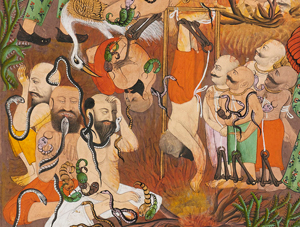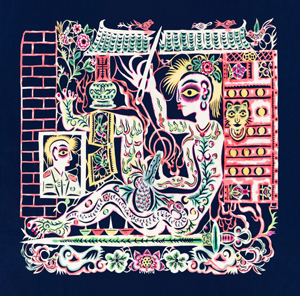To Hell and Back
John Haberin New York City
Comparative Hell, Asian Underworlds, and Xiyadie
Dante is not the only one to have returned from hell. Across centuries and across the largest continent on earth, it was a matter of course.
The only problem is that sufferers returned to hell on earth—and then again to hell. And this time it could be permanent. If not, the cycle surely was, and only the enlightened could break it. As for creative artists, they could only imagine the trip to hell and back, in a show titled "Comparative Hell: Arts of Asian Underworlds" at Asia Society. It offers a cook's tour of hell, Asian art, and four religions on both the society's gallery floors, and then it stops for young artists who take their cues from older myths and present-day woes, even as Xiyadie brings his "Queer Cut Utopias" to the Drawing Center. Is even that enough to map the underworlds? 
The vicious circle
Dante was hardly the first to have gone willingly to hell, nor would he be the last. At the very dawn of western literature, Homer sends Odysseus to the underworld on the hero's long, perilous journey home. To his surprise, the men that he fought alongside and admired would rather have been unknown on earth than the stuff of legend in the next life. Think of Satan in Paradise Lost, who would rather reign in hell than serve in heaven. Opposed as they are, Dante's circles of hell have their counterparts in Asian art from India to Japan. John Milton, too, could be speaking for the unenlightened in Asia when he has Satan declare that "I myself am hell."
Oh, hell. You might say it in annoyance or with a shrug. You might have had enough of it from the religious right in America, but not from Western art. It holds scenes from the Gospels and the creation, prophets and saints, but not half so much of hell. Are eastern art and literature any different? The Koran has its warnings of hell, but many more promises of salvation with virgins for the taking. Heaven is just too good to pass up.
But then hell is way too messy, scary, intricate, and entertaining to ignore—and too central to Asian tradition. The show's title may sound dry, like a course in comparative religion. It may sound like too much to take in as well. You may find yourself at a given moment in Tabriz in 1555, Edo Japan around 1800, Thailand in the late nineteenth century, or today. You will encounter Islamic miniatures, scrolls, tapestries, and sculpture. Can anyone do justice to so much?
Not really, and an organization by theme furthers the impression of a single, unchanging culture. Wall text on the way in boils Jainism, Hinduism, Buddhism, and Islam down to a couple of paragraphs each. They end up sounding much the same—and so they should. The society wants you to see them like that. All but Islam share a belief in souls caught up in a vicious circle. It is the circle of life and death, and just try to tell the two apart.
The very first work, from Korea, depicts the Wheel of Life, but this is not a game show. It opens sections on mapping hell and numbering its judges, and neither is an easy task. Hell for some has two hundred seventy-four subsections, seven layers apiece, and ten kings. Dante got off easy with nine circles. A painting depicts one subsection as an entire city, with palaces, courtyards, a place literally to bathe in passion, and ever so much more. Hell itself is a scene from life.
A battle here on earth offers a transition to the show's third section, on punishments. Its warriors on horseback and tormented losers could put hell to shame. But then it borrows its demons and their tortures from hell. Medieval monsters and their Renaissance successors look serene by comparison—and a lot less funny. Hieronymus Bosch, for one, pairs heaven and hell, not hell and earth. Christianity, too, has it easy.
Hell no
After punishment comes salvation, a breaking of the circle. It may appear as no more than a change of tone. A modern take on salvation, from Indonesia in 1970, is packed as hell, but in gloriously bright colors. The Mahabharatas and Budhisattvas who guide souls to salvation have their counterparts in the earlier judges, but the stern faces and weighty stone are gone. (How much the differences reflect distinct religious and national traditions I leave to experts.) Enlightenment includes an escape from earthly passions, as Dante's Paolo and Francesca came to know, because hell has given way to love.
The exhibition itself has changed. Salvation has much of an entire floor, with works well separated. The curators seek a more leisurely pace and a greater release, quite as much as the saved. Not that the tensions can altogether vanish. The section for punishment includes images of Muhammad (with trigger warnings) that some in Islam forbid. He looks less a judge than an emcee.
Is this impiety? Those who think so should remember that, to others who share their faith, it is essential. What of the faithful and unfaithful in the present? One last room has just three works by four contemporary Asian artists. Luis Lorenzana, a Philippine artist, has his demons, with exaggerated teeth and eyes. Step back, and a figure from above flies to the rescue.
Who here are saints, and who are sinners? Tsherin Sherpa, from Katmandu via San Francisco, sees heavenly and earthly dangers. Facing figures in gas masks emerge from a sea of tiny sculls that could pass for smileys. Lu Yang in China puts the burden on himself, with Delusional Crime and Punishment. On video, he scratches away at his own skin. It might be the delusion, the crime, or the punishment.
The exhibition still feels like snapshots from something larger. The less crowded floor only accentuates the gaps. Even the contemporary artists leave room for more—quite apart from Xiyadie, a Chinese artist, at the Drawing Center. Yang, for one, has taken his project to additional videos and prints. After the show's opening wheel, his "wheel of misfortune" would make a fitting ending. But then the gaps are a reminder that a westerner like myself has much to learn.
Can a westerner, too, become trapped in the cycle? The confluence of life and death, in all its pageantry, should sound familiar. As Jean-Paul Sartre had it, hell is other people. I felt my own release with one last contemporary artist, from Iran. Afruz Amighi suspends shapes between lampshades and bodies from chains. Their shadows on the walls arrest the room's strong lights and move with its gentle currents.
Stepping out
"Here I can dance with abandon. I can love. I can hate. I can be free." Xiyadie does not mean New York, although I hope he could get in a few steps for his opening at the Drawing Center. He has in mind his imagination, but it puts a heavy burden on a modest exhibition, as "Queer Cut Utopias."
 A queer artist in an oppressive nation, he faced every obstacle to freedom. Born in the chill air of northwest China, he adopted his one-named identity, meaning the Siberian Butterfly. He was a young adult in 1989, the year of student protests and the Tiananmen Square massacre, killing hundreds or even thousands. Titles allude to its site in a once-gated city, but he adopts Asian architecture and traditions as his own. Motifs include brick walls, and you can see why he retains the right not just to love, but also to hate. Float like a butterfly, a black American said; sting like a bee.
A queer artist in an oppressive nation, he faced every obstacle to freedom. Born in the chill air of northwest China, he adopted his one-named identity, meaning the Siberian Butterfly. He was a young adult in 1989, the year of student protests and the Tiananmen Square massacre, killing hundreds or even thousands. Titles allude to its site in a once-gated city, but he adopts Asian architecture and traditions as his own. Motifs include brick walls, and you can see why he retains the right not just to love, but also to hate. Float like a butterfly, a black American said; sting like a bee.
For all that, he shows few signs of hate in his art, and he calls his most striking work, Joy. If joy still comes with mixed signals, you will understand. The figure at its center has ten arms, but it drapes from a coat hanger, with a finger in one eye. He could almost have been quoting Groucho Marx: "I am going back in the closet, where men are empty overcoats." Still, that figure literally has balls.
Gender for this butterfly is always fluid, but lovers hold center stage—naked, erect, and fondling each other's breasts. Nudity can also mean innocence, and they surround themselves with children, fish, a tiger or a pussycat, and flowers. The compositions approach symmetry, and they have a decorative underpinning in floral cut paper. Their patterning and porn recall South Asian art, but he has not given up on China. A lot has changed over the years, and he showed at the LGBT Center in Beijing in 2010. He turns sixty later this year.
Xiyadie has the smaller back and downstairs galleries, while "Of Mythic Worlds" takes shape in the main space. They sound like a perfect match, and the group show has an intriguing mix of historical figures like Lee Bontecou and Georgia O'Keeffe, new contexts for such politically aware artists as Betye Saar and Barbara Chase-Riboud (a sketch for her Foley Square Monument of 1996), and a slew of unfamiliar names. Who knew that Roland Barthes, the writer, indulged himself in colored ink? In practice, though, their works on paper are dark and smudged or fading into white, and mythic worlds are slow in coming. O'Keeffe has a lightly sketched abstraction, untitled at that, while more than one artist has only a grid.
Xiyadie, in contrast, is full of color, with explicit myths. They are at their best against a black background and on a large scale, although he works things out on ordinary white paper. Still, they dance around the burdensome complexity of love and hate. A single crowd scene, nearly six feet across and bitter in its anonymity, never lives up to its promise. "Here," he adds, "I can give free rein to my imagination." Share in the pleasure, but do not ask for more.

"Comparative Hell" ran at Asia Society through May 7, 2023, Xiyadie at the Drawing Center through May 14.




